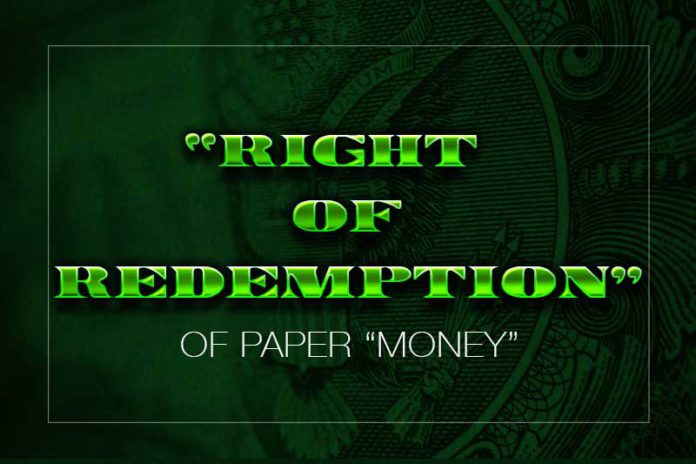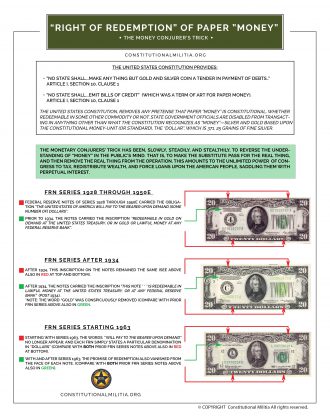Last Updated on September 2, 2022 by Constitutional Militia
“Right of Redemption” of Paper “Money”
The devolution of Federal Reserve Notes (FRNs) from a paper currency redeemable in gold to one redeemable only in slugs is explicable economically and politically: To introduce the FRN as a new paper currency in 1913, the government had to tie it by a right of redemption to the circulating money of that day, gold coin.[1] And then, to transmogrify the FRN into a currency fit for limitless inflation, the government had to cut that tie to gold (and silver as well). The change in the mere language printed on the FRNs , and in their redeemability in gold, could not transform that currency’s legal character, however. If FRNs were not “dollars” when they explicitly promised to pay in gold, they did not magically become “dollars” when they stopped explicitly promising to pay in anything at all, and statutorily can be redeemed in nothing better than base-metallic coins.
“Right of Redemption” of paper “Money”: The Monetary Conjurer’s Trick
From the very first, Federal Reserve Notes were denominated “advances” and “obligations”—that is, instruments and evidence of debt. True “money”, however, is the most liquid of all assets, not a debt that might be repudiated, and certainly not a debt that has been serially repudiated. And if Federal Reserve Notes were from the start to be “redeemed * * * in gold or lawful money”, they obviously were never conceived to be either “gold” or “lawful money”. So, because by definition the only official “money” the law recognizes is “lawful money”, by law Federal Reserve Notes were never (and are not now) actual “money” at all, but at best only some sort of substitute for “money”.
The monetary conjurers’ trick has been, slowly, steadily, and stealthily, to reverse this understanding in the public’s mind. That is, to make the substitute pass for the real thing, and then remove the real thing from the operation. This subterfuge was not overly difficult to put over. After all, in the term “redeemable currency”, which is the noun and which the adjective? When people deal with a “paper currency redeemable in gold”, the natural uninstructed inclination is to treat the paper currency as “money” and the gold as something else. The paper currency, as the saying goes, is merely “backed” by gold—but of course is not itself gold. And because the currency is not itself gold, the money-manipulators can remove the gold “backing” farther and farther into the background, without affecting the nature of the paper as “currency” (at least nominally). Thus, a “redeemable currency” can be converted into a “contingently redeemable” or “conditionally redeemable” currency, through temporary suspension of specie payments (as happened repeatedly during the Nineteenth Century); and then into a full-fledged “irredeemable currency”, through permanent suspension of specie payments, as with Federal Reserve Notes after 1933 domestically and 1971 internationally.[2] Yet, to the average citizen (whose most serious liability is mental inertia), even though a paper currency’s promise of redemption has been dishonored, it nonetheless remains “currency”.[3]
Thus one grasps that the so-called “right to redemption” attached to any paper currency is actually a liability, inasmuch as it exposes the holders of that currency to repudiation and expropriation, because they possess only the paper, not the gold. Even in the best of times, the holders of redeemable paper currency are not economically and politically independent. Rather, they depend upon the honesty and the competence of the money-managers. This is why America’s Founding Fathers, realists all, denominated redeemable paper currency as “bills of credit”. They knew that such bills’ values in gold or silver are always contingent upon the issuers’ credit—that is, ultimately, the issuers’ honesty and ability to manage their financial affairs. The unavoidable trouble with “bills of credit”, though, is that they can (and usually do) turn out to be “bills of discredit”, when the holders discover that the money-managers are dishonest and incompetent—or worse, as is the situation today, highly competent at dishonesty. Then the holders of the paper currency (if they are sufficiently astute) realize how unwise it is to allow the gold to remain in the custody of the very institutions and individuals with the greatest incentives, and the uniquely favorable positions and opportunities, to steal it.[4]






























